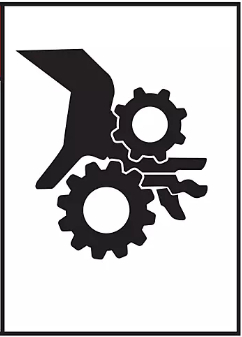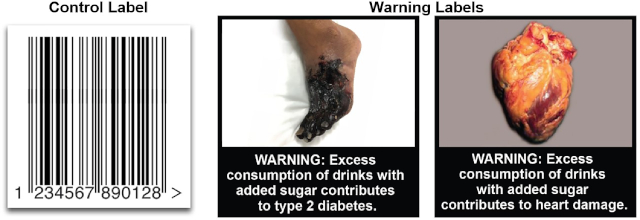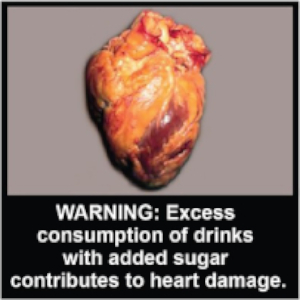You’d think picture warning labels about the dangers of sugary beverages would be aimed at kids. But a new study reveals that they work best when aimed at parents – who often make food and beverage choices on behalf of their children. One way or the other, it proves that pictures speak louder than words…
 A standard industrial warning label, and one of my favourites
A standard industrial warning label, and one of my favourites
for graphic intensity: There’s no mistaking its message…
Which is conveyed clearly without any words.
Researchers at the University of North Carolina wanted to see if picture warning labels would work better than written ones getting the message across to consumers. In this case, they were specifically concerned with warning buyers about the dangers of sugar-sweetend drinks, which have been pegged as major contributors to childhood obesity and type 2 diabetes.
Previous surveys clearly showed that kids in the U.S. and many other countries consume more than the recommended maximum of sugary drinks, which increases their risk for obesity and diet-related chronic diseases, including Type 2 diabetes and heart conditions. On top of that, the studies revealed that the health problems associated with sugary drinks were considerably more serious among Black and Latino demographics.
What they did
The team set up the UNC Mini Mart, a small space, “set up to mimic a convenience store shopping experience.” Unlike a real store, they could control all aspects of the setting including how and where products were displayed as well as what products were offered.
For purposes of the experiment, 326 parents (25 percent Black, 20 percent Latino) of children ages 2 to 12 years old participated in a randomized trial with two phases. A pictorial phase used drink labels with images representing heart damage and Type 2 diabetes. In the control phase, drinks displayed a barcode in the same label space. The parents were asked to fulfill a shopping list that included not only beverages, but other household items, masking the true intent of the experiment and helping keep the results ‘clean’.
What they found
The numbers clearly show how effective pictorial warnings were, at least in the context of the experiment: In the pictorial phase, only 28 percent of parents bought sugary drinks for their kids. In the control phase, 45 percent of parents chose sugary drinks.
In addition, the benefits of the picture warnings were similar according to parent characteristics, including race, ethnicity, and socioeconomic status, suggesting picture warnings could work equally well across diverse populations.
The takeaway
“Showing that warnings can cut through the noise of everything else that’s happening in a food store is powerful evidence that they would help reduce sugary drink purchases in the real world,” study report senior author Dr. Lindsey Smith Tailli observes. ”
Study report lead author Marissa G. Hall adds, “We think the paper could be useful for policymakers in the U.S. and globally. This evidence supports strong, front-of-package warnings to reduce sugary drink consumption in children.”
My take
As a society, we already accept that pictures speak louder than words. We place standardized warming pictures on corrosive chemical products showing a skeletal hand immersed in a liquid. A skull and crossbones unequivocally warns of poison. Everybody knows a lightning bolt means high voltage.
But how do you represent obesity pictorially? Diabetes? Heart disease? The study team used these pictorials in their experiments:

The first thing I notice is, they’re not just pictorials. They’re more like the mandatory warnings most jurisdictions now require on tobacco products. They need a written message to explain the picture. Oh, well. I guess the idea is that the pictures get the consumer’s attention. But it’s not my idea of a picture warning. I assumed one of the goals of picture warnings was to get the message across with equal force and clarity regardless of the educational, ethnic or social background of the viewer. But I suspect some readers will say I’m just sour-grapesing. After all, the study pictorials did do what they were supposed to do in the experiments.
Still… We all know that the warnings on tobacco products haven’t wiped out smoking, no matter how gruesome the photos are. Tobacco is an addictive substance and no amount of horrific pictures will cure addiction. In fact, I’ve heard smokers who are in deep denial dismiss the tobacco pack warnings as childish attempts to influence their ‘free choice’. I note, I hope justifiably, that sugar has been found to be just as addictive as tobacco or caffeine. And I wonder how successful the warnings as proposed by the study team would be ‘in the wild’, where many older kids choose their own beverages.
I guess we’ll have to wait and see…
~ Maggie J.

